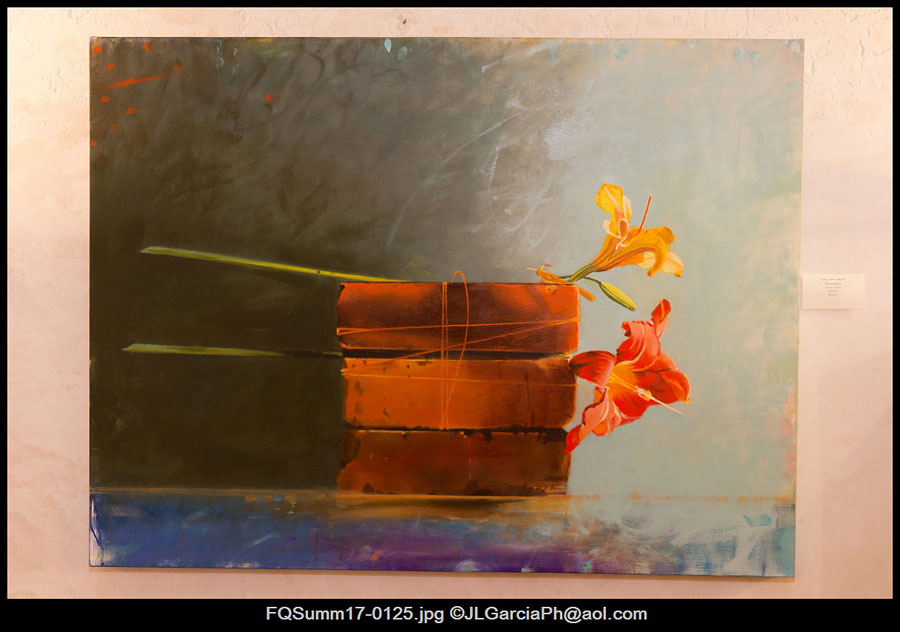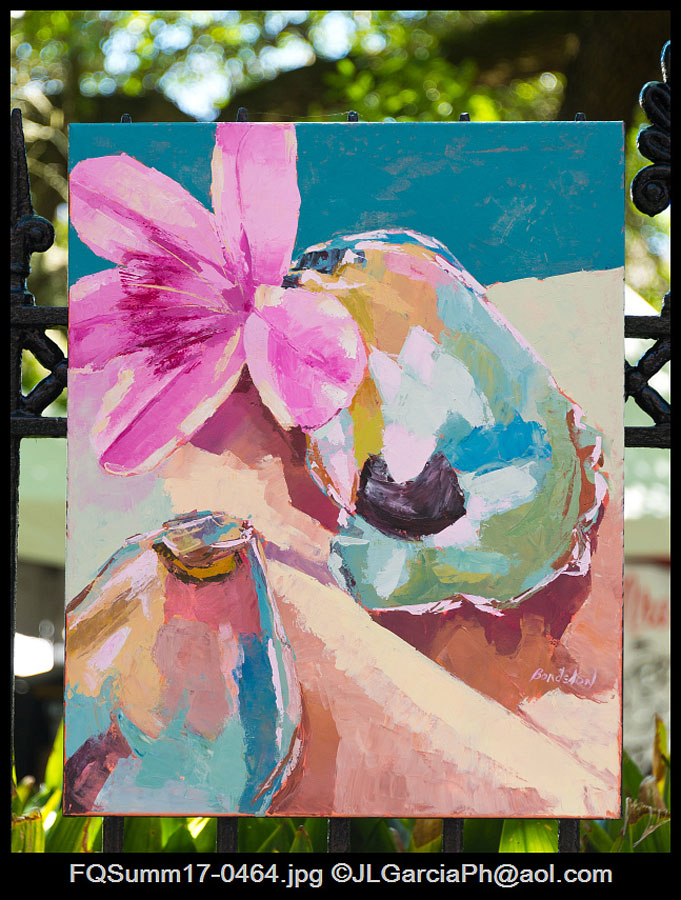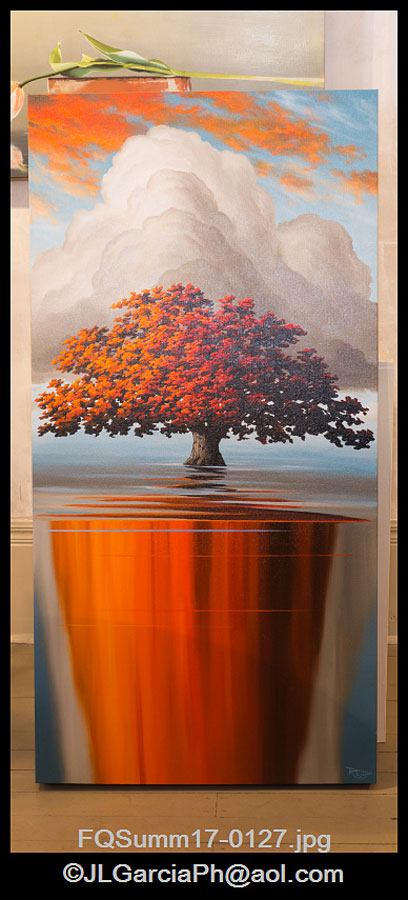May 02, 2017
Besides raindrops on roses and whiskers on kittens, flowers are a few of my favorite things; dubbed, by yours truly, as nature’s labor of love. When the dog bites or the bee stings, it is flowers that we use to pull us up out of the dumps and help us to “get it together Mary”, another saying dubbed by yours truly.
In fact, I am known for saying things, lots of things. Every once in a blue moon one of them is actually smart and backed with real facts, instead of just Twitter. In my college painting class, I said in a desperate attempt to impress my professor, that I thought flowers were the nature’s labor of love. My professor sprung to his feet and because he was so inspired by my words, he decided to add florals to our already very jammed assignment list. I was fine with that; I had studied painting flowers since before I could say “you’re drunker than Tammy Faye on Jesus”.
When I sat down for brunch at the Country Club in the Bywater, my eyes found comfort with the “Grande Dame” of an already memorizing renovation: the floral creations of artist Cindy Mathis. It’s hard to find an opus in this collection of florals that takes us on a visual expedition through any one of the momentous courtyards and green spaces in the city. Mathis captures the same feel and emotion with a multitude of styles. This alone is something that is not fluent for most artists. Mathis, a self-taught phenom, spent her days during the renovations panting on site. Working around scaffolds, dust, and the typical renovation woes, she created beauty from the ashes of what the Country Club used to be, and lead the visual second line to its new face front. Like most self-taught artists, it was at bit difficult for her to get her head around the idea that people really loved her work and wanted it. “I don’t have just one niche,” she said rather matter of fact. “I can paint in any style, I have trained myself to do it and see images in many different ways.” The key to painting flowers is training yourself to see something that no one else sees. Flowers are unique to themselves because even in a bundle of varying species, each flower looks, feels, and reacts to light differently. Artists that can envision things in different forms usually find painting flowers quite rewarding.
With roots in teaching, Mathis says if you can sign your name then she can teach you to paint. “Anyone can learn to paint, I promise, I can teach you.” Living her artistic life according to the mantra, “Dream, Create, Repeat” is what keeps this go-getter getting more and more noticed in a community that can sometimes label floral artists and kichty or not formally trained enough. Mathis just about “blows the door of this Cadillac”, if you know what I mean. You can see her entire complete collection of paintings and murals at the country club at 634 Louisa Street in the Bywater.
Almost as much as snowflakes that stay on my nose and eyelashes, Arlos Gallery at 837 Chartres Street is quickly becoming one for my all-time favorite things. This gallery goes beyond an appreciation for artwork because it also gives you an appreciation for a good time. Something tells me you know what I am about to say! Yes, they love flowers! Often mistaken for a flower shop, this sweet little slice of the New Orleans gallery world is owned and operated by a fellow flower junkie, Mary Booney and features a few unexpected surprises. The gallery is named after a dog, you just might meet upon visiting, is the home to what is assuredly one of the most whimsical collections in the French Quarter. Sculptures and colors tango through this assemblage from artists that tilt the scale to allow us to see the fun in creating art. By refusing to get bogged down with the business of art and continuing to celebrate art for what it is, this gallery is a constantly evolving inspiration.
Artist Karen Haynes clearly finds inspiration in the simple things in life and art. Single flowers are delicately wrapped with items that do not share the same exquisite softness or fragility. A single cut white tulip lies lifeless on a red mason’s brick in “Droplet”, yet so much life is coming from the painting. It is the direct contrast of the two items that makes the artwork evoke a feel and an appreciation for both the flower and the inanimate object. The soft, beautiful flowers against the rustic charm and hard surface of the brick creates a visual and emotional contradiction that counter what she is creating. For what it is worth, Haynes is creating still-life paintings. However, there is nothing “still” about this work. While the items in the paintings are things we see every day, we are seeing them in a way that differs from what we normally experience. Haynes takes a simple approach to something and pushes to a point where we become surprised by the outcome. Her backgrounds are as important as her subjects because they provide us with a great translator to what the artist is actually saying. It’s not just a still-life, it’s not just a rose and a brick, it is art with a message and intent. While Haynes opts to create just one flower, artist Reid Richardson prefers the entire tree, floating on a cloud, in the air. It is clever to take an artist like Reid Richardson and place him in a collection with Karen Haynes because it gives everyone a chance to see that simplicity in content is one thing, while simplicity in form is another. Reid Richardson has simplicity in form given that his images appear detailed and lifelike. The form of the work is simple, while the message stays neatly tucked away waiting for you to discover it. Cumulus clouds play a large roll in this artist’s work, but don’t over shadow the importance of the single tree representing a host of things from simple metaphor, to the messages of hope for the future.
Along the fence of Jackson Square, you can find just about anything you want to satisfy your art cravings. Floral artist Ferris Hotard’s flowers are something to take a bite of. Having shone across the country at venues the same size and larger than Jackson Square, Hotard has created a style that is not only typically floral, but typically New Orleans. Typical is not a bad thing because an artist can take imagery we are accustom to and paint it in a way that we see often, still leaving us with a lasting impression. How? That’s an easy one because Hotard paints with passion. Each one of his paintings screams passion from an artist that calls upon his friends and family in the art community for inspiration and love. Hotard has a good, solid core and is “good people”, as I like to say. Hotard’s work reflects that. He centers his work on the foliage found in Southeast Louisiana and the famed gardens of New Orleans. Hotard has developed a look that people recognize. Often times combining the feel of stained glass and the fluidity of water together for a near watercolor feel. Hotard allows texture, but his work is at its best when paint is thinly applied and almost translucent. Self-taught, this floral master has a very strong opinions about art lessons. He thinks life offers enough lessons already and practice makes perfect. People just starting out should paint as much as they can in Hotard’s opinion. “The more you paint the better you become.”
Well, after all of this, I am in the mood for cream-colored ponies and crisp apple strudels. When you are lucky enough to get the opportunity to be surrounded by artists and art as much as I am, choosing a favorite can be like “sleeping on a cement pillow.” Some say choices are the “medicine to madness,” but as nature creates one flower more beautiful than the other, talented artists will continue to recreate them, and I will bear the burden of choosing my favorites.
In fact, I am known for saying things, lots of things. Every once in a blue moon one of them is actually smart and backed with real facts, instead of just Twitter. In my college painting class, I said in a desperate attempt to impress my professor, that I thought flowers were the nature’s labor of love. My professor sprung to his feet and because he was so inspired by my words, he decided to add florals to our already very jammed assignment list. I was fine with that; I had studied painting flowers since before I could say “you’re drunker than Tammy Faye on Jesus”.
When I sat down for brunch at the Country Club in the Bywater, my eyes found comfort with the “Grande Dame” of an already memorizing renovation: the floral creations of artist Cindy Mathis. It’s hard to find an opus in this collection of florals that takes us on a visual expedition through any one of the momentous courtyards and green spaces in the city. Mathis captures the same feel and emotion with a multitude of styles. This alone is something that is not fluent for most artists. Mathis, a self-taught phenom, spent her days during the renovations panting on site. Working around scaffolds, dust, and the typical renovation woes, she created beauty from the ashes of what the Country Club used to be, and lead the visual second line to its new face front. Like most self-taught artists, it was at bit difficult for her to get her head around the idea that people really loved her work and wanted it. “I don’t have just one niche,” she said rather matter of fact. “I can paint in any style, I have trained myself to do it and see images in many different ways.” The key to painting flowers is training yourself to see something that no one else sees. Flowers are unique to themselves because even in a bundle of varying species, each flower looks, feels, and reacts to light differently. Artists that can envision things in different forms usually find painting flowers quite rewarding.
With roots in teaching, Mathis says if you can sign your name then she can teach you to paint. “Anyone can learn to paint, I promise, I can teach you.” Living her artistic life according to the mantra, “Dream, Create, Repeat” is what keeps this go-getter getting more and more noticed in a community that can sometimes label floral artists and kichty or not formally trained enough. Mathis just about “blows the door of this Cadillac”, if you know what I mean. You can see her entire complete collection of paintings and murals at the country club at 634 Louisa Street in the Bywater.
Almost as much as snowflakes that stay on my nose and eyelashes, Arlos Gallery at 837 Chartres Street is quickly becoming one for my all-time favorite things. This gallery goes beyond an appreciation for artwork because it also gives you an appreciation for a good time. Something tells me you know what I am about to say! Yes, they love flowers! Often mistaken for a flower shop, this sweet little slice of the New Orleans gallery world is owned and operated by a fellow flower junkie, Mary Booney and features a few unexpected surprises. The gallery is named after a dog, you just might meet upon visiting, is the home to what is assuredly one of the most whimsical collections in the French Quarter. Sculptures and colors tango through this assemblage from artists that tilt the scale to allow us to see the fun in creating art. By refusing to get bogged down with the business of art and continuing to celebrate art for what it is, this gallery is a constantly evolving inspiration.
Artist Karen Haynes clearly finds inspiration in the simple things in life and art. Single flowers are delicately wrapped with items that do not share the same exquisite softness or fragility. A single cut white tulip lies lifeless on a red mason’s brick in “Droplet”, yet so much life is coming from the painting. It is the direct contrast of the two items that makes the artwork evoke a feel and an appreciation for both the flower and the inanimate object. The soft, beautiful flowers against the rustic charm and hard surface of the brick creates a visual and emotional contradiction that counter what she is creating. For what it is worth, Haynes is creating still-life paintings. However, there is nothing “still” about this work. While the items in the paintings are things we see every day, we are seeing them in a way that differs from what we normally experience. Haynes takes a simple approach to something and pushes to a point where we become surprised by the outcome. Her backgrounds are as important as her subjects because they provide us with a great translator to what the artist is actually saying. It’s not just a still-life, it’s not just a rose and a brick, it is art with a message and intent. While Haynes opts to create just one flower, artist Reid Richardson prefers the entire tree, floating on a cloud, in the air. It is clever to take an artist like Reid Richardson and place him in a collection with Karen Haynes because it gives everyone a chance to see that simplicity in content is one thing, while simplicity in form is another. Reid Richardson has simplicity in form given that his images appear detailed and lifelike. The form of the work is simple, while the message stays neatly tucked away waiting for you to discover it. Cumulus clouds play a large roll in this artist’s work, but don’t over shadow the importance of the single tree representing a host of things from simple metaphor, to the messages of hope for the future.
Along the fence of Jackson Square, you can find just about anything you want to satisfy your art cravings. Floral artist Ferris Hotard’s flowers are something to take a bite of. Having shone across the country at venues the same size and larger than Jackson Square, Hotard has created a style that is not only typically floral, but typically New Orleans. Typical is not a bad thing because an artist can take imagery we are accustom to and paint it in a way that we see often, still leaving us with a lasting impression. How? That’s an easy one because Hotard paints with passion. Each one of his paintings screams passion from an artist that calls upon his friends and family in the art community for inspiration and love. Hotard has a good, solid core and is “good people”, as I like to say. Hotard’s work reflects that. He centers his work on the foliage found in Southeast Louisiana and the famed gardens of New Orleans. Hotard has developed a look that people recognize. Often times combining the feel of stained glass and the fluidity of water together for a near watercolor feel. Hotard allows texture, but his work is at its best when paint is thinly applied and almost translucent. Self-taught, this floral master has a very strong opinions about art lessons. He thinks life offers enough lessons already and practice makes perfect. People just starting out should paint as much as they can in Hotard’s opinion. “The more you paint the better you become.”
Well, after all of this, I am in the mood for cream-colored ponies and crisp apple strudels. When you are lucky enough to get the opportunity to be surrounded by artists and art as much as I am, choosing a favorite can be like “sleeping on a cement pillow.” Some say choices are the “medicine to madness,” but as nature creates one flower more beautiful than the other, talented artists will continue to recreate them, and I will bear the burden of choosing my favorites.






